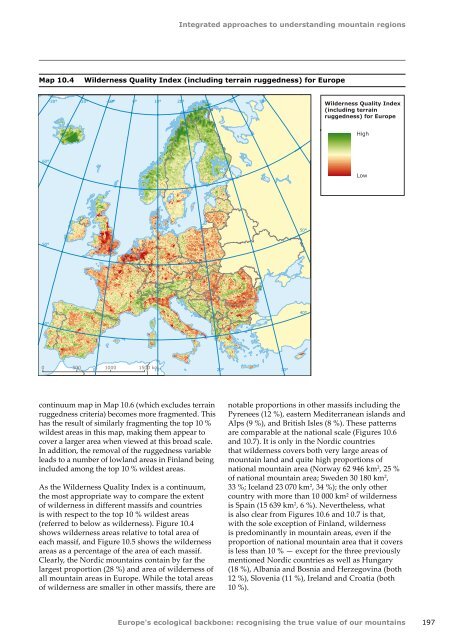Europes ecological backbone.pdf
Europes ecological backbone.pdf
Europes ecological backbone.pdf
You also want an ePaper? Increase the reach of your titles
YUMPU automatically turns print PDFs into web optimized ePapers that Google loves.
Integrated approaches to understanding mountain regions<br />
Map 10.4<br />
Wilderness Quality Index (including terrain ruggedness) for Europe<br />
-30°<br />
-20°<br />
-10°<br />
0°<br />
10°<br />
20°<br />
30°<br />
40°<br />
50°<br />
60°<br />
Wilderness Quality Index<br />
(including terrain<br />
ruggedness) for Europe<br />
60°<br />
High<br />
60°<br />
Low<br />
50°<br />
50°<br />
40°<br />
40°<br />
0 500<br />
0°<br />
1000 1500 km<br />
10°<br />
20°<br />
30°<br />
continuum map in Map 10.6 (which excludes terrain<br />
ruggedness criteria) becomes more fragmented. This<br />
has the result of similarly fragmenting the top 10 %<br />
wildest areas in this map, making them appear to<br />
cover a larger area when viewed at this broad scale.<br />
In addition, the removal of the ruggedness variable<br />
leads to a number of lowland areas in Finland being<br />
included among the top 10 % wildest areas.<br />
As the Wilderness Quality Index is a continuum,<br />
the most appropriate way to compare the extent<br />
of wilderness in different massifs and countries<br />
is with respect to the top 10 % wildest areas<br />
(referred to below as wilderness). Figure 10.4<br />
shows wilderness areas relative to total area of<br />
each massif, and Figure 10.5 shows the wilderness<br />
areas as a percentage of the area of each massif.<br />
Clearly, the Nordic mountains contain by far the<br />
largest proportion (28 %) and area of wilderness of<br />
all mountain areas in Europe. While the total areas<br />
of wilderness are smaller in other massifs, there are<br />
notable proportions in other massifs including the<br />
Pyrenees (12 %), eastern Mediterranean islands and<br />
Alps (9 %), and British Isles (8 %). These patterns<br />
are comparable at the national scale (Figures 10.6<br />
and 10.7). It is only in the Nordic countries<br />
that wilderness covers both very large areas of<br />
mountain land and quite high proportions of<br />
national mountain area (Norway 62 946 km 2 , 25 %<br />
of national mountain area; Sweden 30 180 km 2 ,<br />
33 %; Iceland 23 070 km 2 , 34 %); the only other<br />
country with more than 10 000 km² of wilderness<br />
is Spain (15 639 km 2 , 6 %). Nevertheless, what<br />
is also clear from Figures 10.6 and 10.7 is that,<br />
with the sole exception of Finland, wilderness<br />
is predominantly in mountain areas, even if the<br />
proportion of national mountain area that it covers<br />
is less than 10 % — except for the three previously<br />
mentioned Nordic countries as well as Hungary<br />
(18 %), Albania and Bosnia and Herzegovina (both<br />
12 %), Slovenia (11 %), Ireland and Croatia (both<br />
10 %).<br />
Europe's <strong>ecological</strong> <strong>backbone</strong>: recognising the true value of our mountains<br />
197

















